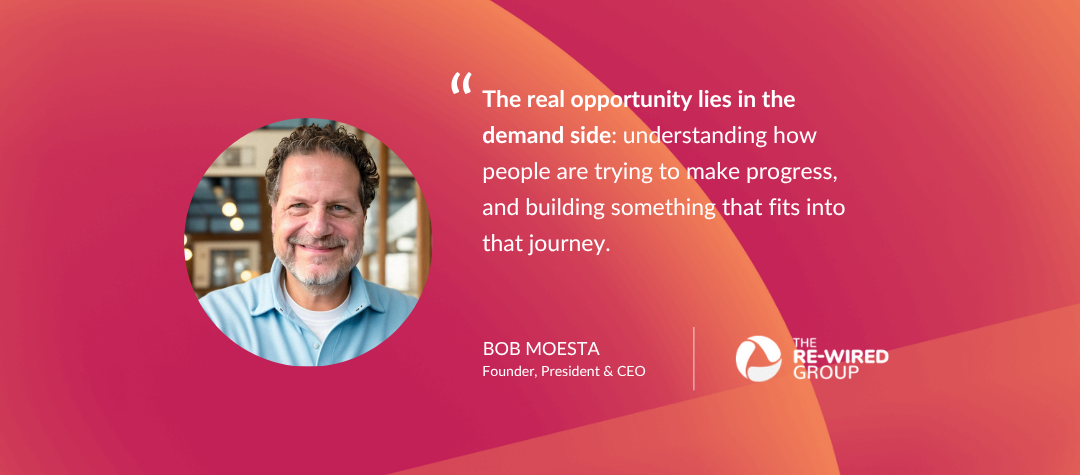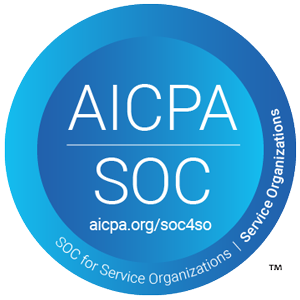What Facebook, Intuit, and SNHU got right about demand-side innovation
Disclaimer: The opinions represented here are those of the individual and do not necessarily represent those of their current or former employer.
Innovation is often framed as a visionary’s art. A spark of genius that drives revolutionary products. But Bob Moesta, President & CEO of the Re-Wired Group, author of four books, and proponent of the Jobs to Be Done theory, sees it differently. We interviewed Bob to get his practical insights from decades of helping teams build better products and gain insights rooted in understanding the real reasons customers choose to buy, switch, or abandon.
From mentoring under Clayton Christensen, working with companies like Facebook, Intuit, and Southern New Hampshire University to helping launch over 3,500 products, Bob has seen firsthand how customer motivations shape successful innovation. His advice? Stop guessing what customers might want in the future. Instead, study what caused them to act in the past.
Watch the full video below, or read on for a selection of key takeaways.
Key takeaways:
- Start every innovation effort with a real customer story. Understand what causes a person to say, “today’s the day,” and build backward from there.
- Avoid “job washing.” Base your product decisions on observed behavior, not rationalized assumptions.
- Interrogate the past, don’t speculate about the future. Uncover causal mechanisms through careful interview techniques rooted in behavioral inquiry.
- Structure hackathons around problems, not ideas. Anchor team creativity in real customer struggling moments to generate more meaningful solutions.
- Differentiate why customers hire your product from why they stay. Growth depends just as much on reducing churn as increasing acquisition.
Begin With the Moment of Truth
Many teams start with broad market research or trend analysis, but Bob insists that meaningful innovation begins with a single moment: when a customer decides to act. That inflection point holds the key to real demand. By unpacking the emotional, functional, and situational triggers behind it, teams can uncover patterns that no survey or dashboard could reveal.
“I’m a firm believer of what I call the N of one… I want to understand what causes one customer to say today’s the day they need to buy your product… We studied what causes people to say, today’s the day I need to set up an Etsy account… Out of all of that, we were able to learn basically all the dynamics around the industry and set up Facebook Marketplace… Within almost six months, it was almost $4 billion.”
Airbnb followed a similar path. Early research revealed their users weren’t just looking for affordable lodging, they were craving connection, authenticity, and a sense of belonging. This insight reframed Airbnb’s value proposition and shaped everything from branding to UX. By anchoring product and messaging in these deeper emotional drivers, Airbnb redefined customer experience and unlocked massive growth.
Don’t Confuse Rationalization With Reality
It’s easy for teams to sit in a room, build user personas, and hypothesize reasons why customers might want their product. But Bob warns this leads to what he calls “job washing”. Assuming rational behavior where none exists. Real progress starts by understanding the actual causes behind a customer’s decision, not the ones we wish were true.
“People sit in a room and hypothesize all the things a customer can do… But nobody randomly switches to your product. There is actually a causal mechanism behind it… Most small businesses hate QuickBooks. They don’t hate QuickBooks, they hate accounting… We made QuickBooks very simple and very easy. The result is that it helps people make progress.”
Slack uncovered similar truths in its early days. Rather than pitch itself as a messaging tool, the team observed how disjointed email threads and file sharing slowed team momentum. By focusing on progress and making collaboration feel seamless, they positioned Slack as a workstream enabler rather than just another software in a busy tech stack. That framing helped it become one of the fastest-growing B2B products of the decade.
Want to run high-impact innovation hackathons in your organization? Hackathon 5 can help you coordinate stakeholders, manage the event, and ensure those post-event action items are tracked to completion. Book a demo.
Ask Like an Investigator, Not a Marketer
Customer interviews aren’t about asking what people want, they’re about uncovering what caused their behavior. Bob’s approach borrows more from intelligence gathering than traditional UX research. The goal can’t be about validating assumptions, but identifying the hidden forces behind decision-making. That means asking detailed, situational questions that reveal motivations people often don’t even realize themselves.
“We never talk to people about the future… Most of the methods that I use are based on criminal and intelligence interrogation… You said this, but did you mean that? These two things don’t connect. What happened?… One example is Southern New Hampshire University… Out of those interviews, we just said: what caused you to say today’s the day to enroll?… We focussed on that, and they’re now the largest university in the world.”
This principle helped Duolingo unlock explosive growth. By running behavior-first user studies, they discovered that emotional triggers, like the fear of losing a streak, kept users engaged far more than typical gamification. They leaned into these insights, designing features like the “daily goal” and “streak freeze,” which now power their retention engine.
Redefine Hackathons Around Real Jobs
Many hackathons start with a vague prompt or open-ended challenge. Bob argues that’s a missed opportunity. Instead, anchor the event around a specific struggling moment and let teams build solutions that help people make real progress. By focusing on tangible user problems, teams can channel their creativity into solutions that address actual needs, leading to more meaningful and impactful outcomes.
“The job should be the foundation of the hackathon… It’s the fundamental difference between how I think about innovation and most people… Instead of ‘build it and they will come,’ I study where people struggle and build something to fit their lives.”
Starting with a problem and building a solution that directly addresses it was no better exemplified than the “Make the Breast Pump Not Suck” hackathon held at MIT. Recognizing the widespread dissatisfaction with traditional breast pumps, the event brought together engineers, designers, healthcare professionals, and parents to reimagine the device. One standout innovation was the “Mighty Mom Utility Belt,” a hands-free, wearable pump designed to offer mobility and discretion for mothers. This user-centered approach led to prototypes that directly addressed the real challenges faced by breastfeeding mothers, showcasing how focusing on specific user struggles can drive meaningful innovation.
Know Why They Stay, Not Just Why They Come
Understanding why customers buy is half the battle. To drive sustainable growth, Bob says, teams must also learn why people leave and recognize that the reasons for staying often evolve over time. It’s not enough to optimize the onboarding experience. Companies need to continuously investigate what features, outcomes, or frustrations shape long-term loyalty or attrition.
“Churn interviews are really important… They didn’t randomly leave you. If you can understand the situations that cause them to leave, you can add features that will keep people… The reason why they bought you is not necessarily the reason why they stay.”
Zoom’s early growth was fueled by ease of use, but user feedback later revealed that reliability and security became critical to retention, especially for enterprise clients. That shift in focus led Zoom to double down on backend performance and security protocols, ensuring that the platform scaled with users’ needs and avoided churn as competitors caught up.
Build With Cause, Not Just Creativity
Innovation isn’t about guessing what might work, it’s about discovering what already does. Bob Moesta’s approach reminds us that true progress begins by understanding the real-life moments that trigger action. Whether you’re designing a product, structuring a hackathon, or reducing churn, the key is to ground every decision in the customer’s context. Look for the causal forces behind choices, not just the features you want to ship.
To explore more of Bob Moesta’s thinking, follow him on LinkedIn where he regularly shares insights on innovation, product strategy, and entrepreneurial problem-solving. He’s also the author of several influential books including Demand-Side Sales, Learning to Build, and Choosing College, all of which dive deeper into the frameworks and stories behind helping people make progress. Check out all of Bob’s books here.
Want to turn customer insight into innovation outcomes? Brightidea’s Hackathon 5 makes it easy to frame challenges around real problems and empower teams to build solutions that truly matter. Get in touch today.


